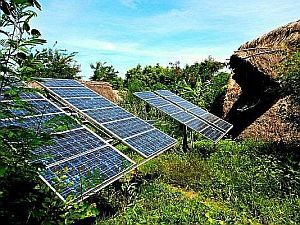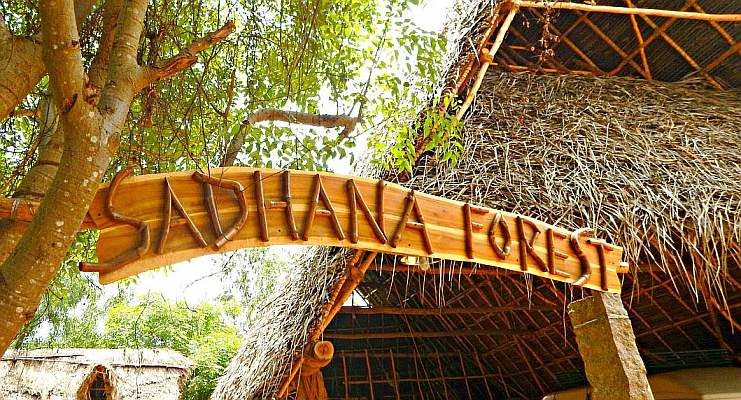A story about the off grid Sadhana Forest in Auroville.
By Sangeetha Sriram
Visit ORGANIC SHOP by Pure & Eco India
Thirteen years ago, when Aviram and Yorit Rozin moved to Auroville with their one-year old daughter Osher, they had one goal in mind: to live a life that embodied seva. They didn’t know the how, when, where and what of it then but their last decade’s journey is a result of, in their own words, a sheer act of surrender.
Aviram, a psychologist and a business executive, and Yorit, a practising architect in Israel, weren’t exactly happy with a way of life that emphasised serving their narrow personal interests. During a visit to India, they fell in love with the country and decided to make India their new home. After living with some communities in India, the Rozins moved to 70 acres of degraded land which was offered to them to steward by the Auroville Foundation. It was a land that no one else had really wanted because of its barrenness and distance from the rest of Auroville. Aviram and Yorit happily accepted the offer and started working on it.
Sadhana Forest is one place where Tagore’s dream of a land “where knowledge is free” is lived. All workshops organised here are offered as a gift
They initially envisioned a small community of families doing afforestation work and living sustainably. But the land had a different plan for them. Almost all the saplings that they planted died, for the land was too dry. However, volunteers started coming in large numbers to experience their way of life and work.
 A guest poses in front of the recycling station at SF
A guest poses in front of the recycling station at SF
Gracefully embracing the unexpected turn of events, they soon saw it become a community of volunteers undertaking water conservation and forestry work. The Rozins, who had no prior background in either of these, started learning on the job: learning to use the A frame, building swales and ponds to harvest rain water, experimenting with innovative tree planting methods and water conservation techniques, ecological buildings, renewable energy, compost toilets, community processes, community cooking and more.
What it is

Sadhana Forest uses only solar and human powered energy
Being a visitor to Sadhana Forest for seven years now, I can easily make a long list of things the community does in response to some of the pressing global crises, ex, being off the grid, using solar and human-powered energy, natural buildings, compost toilets, water harvesting, water conservation, afforestation, veganism, zero waste, permaculture and so on.
In one way, the Rozin family is more Indian than most people who call themselves so. What really drew them to India and compelled them to make it their home is the culture of the place that embodies the truth of Oneness. Here are some values that Sadhana Forest holds dear and lives by:
Daana
At Sadhana Forest, a person’s monetary wealth is just an inconsequential piece of information and do not affect what the community can offer him. Unlike the capitalist system that our society is embedded in (which thrives on turning all that is essential to life, ex, good food, clean water, love and knowledge, into tradable and exploitable commodities), the Rozins believe that these should be available freely and abundantly.
Sadhana Forest is one place where Tagore’s dream of a land ‘where knowledge is free’ is lived. All workshops organised here are offered as a gift. They range from a half-a-day workshop on ‘cooperative games’, a two-day workshop on ‘forestry and water conservation’, a week-long workshop on ‘social entrepreneurship’, to two-month residential course on ‘Permaculture’.
Sadhana forest is funded primarily by the gifts of from all corners of the world. All gifts are appreciated, big or small. Some funds are raised through projects carried out by the community. The criticism that is often raised is of why Sadhana Forest doesn’t sell something to meet ends, such as courses or timber or even vegetables? Evidently, for most people the gift economy that Sadhana Forest practices is very difficult to comprehend. It is thought of as a form of naïveté.
Vasudhaiva Kutumbakam

Natural buildings, compost toilets and water harvesting make up the infrastructure of the community
Sadhana Forest views the world as one family. Among those who I have personally seen cared for at Sadhana Forest are an abandoned mother and child, a couple who were disowned by their larger family and an emotionally unstable woman who felt safe and at home only here. Sadhana Forest is increasingly becoming a refuge for many youngsters who want to live differently and are seeking inspiration and direction. Among these is a steadily increasing stream of fatigued IT professionals from cities like Bangalore, who want to take a break from the tiring treadmill they’re on. They come here to labour with their hands, learn to live lightly on the planet and experience communal living. Local villagers too freely walk in and participate in all aspects of Sadhana life.
Shiksha
Seven-year-old Shalev, Yorit and Aviram’s second daughter, has never been to school. 14-year-old Osher chose to start school just this year. The Rozins have demonstrated that children thrive in a rich intergenerational community that lives with integrity, with members of the community pursuing their unique callings in life, where the physical and emotional environment is safe, where there is a lot of unstructured time, and where children are welcome to participate in most spheres of adult work. When Osher was merely 10 years old, she could cook tasty healthful food for over a 100 people, conduct workshops for adults and children on cooperative games, and participate in conflict resolution processes.
A very important project at Sadhana Forest is the ‘Children’s Land’. Located on 2.7 acres of land, it was entirely designed, planned and created by the local village children with help from adults. Trees, a small garden, a compost toilet, a small recycling station, a kitchen, an activity centre are all part of this space. On four days of the week, children from local villages are brought here to spend half a day. The volunteers anchoring the sessions ask the children what they are interested in doing and continuously co create these activities with the children.
Seva & Ahimsa
In today’s world, where work is seen as drudgery that needs to be outsourced either to machines or to lower-caste people, it is rare to find a community that not only resorts to neither of these, but calls it ‘Seva’. All the tasks in the community from cooking, gardening to cleaning the toilets are shared by those who live there. One can often hear a volunteer shout out, “Time for second Seva of the day!” It’s built into Sadhana Forest’s vocabulary.
Sadhana Forest also holds dear the value of ahimsa. “Animals are repeatedly ill treated for the things we extract from them, including their milk. One of the ways we care for them is to refrain from consuming any of these products,” say the Rozins.
What the Future Holds
“We dream of a goshala to take care of cattle rescued from butchers not because they can give us something in return but because they deserve a good life and it is growth opportunity through selfless service. We dream of bringing in and mentoring young adults who leave orphanages to help them transition into healed, skilled and confident adults. We dream of having a lot more Indian families make this their home. We dream of taking in terminally ill children and giving them a dignified life. We dream of undertaking a jal yatra (water pilgrimage) across India, implementing water harvesting and conservation in the dry lands of the country.”
According to the Rozins, the most important message that Sadhana Forest has for the world is that ‘Change is possible!’ “Sadhana Forest grows through all the young people who have gone in different directions, but live their own callings,” says Aviram.
| HIGHLIGHTS OF SADHNA FOREST (across India, Haiti and Kenya)
· 1, 000 volunteers visit the India based Sadhna Forest every year, and thousands more visit the other two · Sadhna is home to170 tree species that make up the tropical dry evergreen forest, many of them food bearing · 1,21,000 trees planted so far · Over 80% average survival rate of trees planted · 21,500 people have been trained in permaculture techniques by the Sadhna Forest Team · Over 9,000 volunteers have stayed in SF communities for any length of time between two weeks to six years |
Reproduced with permission from: www.vikalpsangam.org
Note: This article has been condensed to fit desired word count



I would like to know more
Kindly contact them at http://www.sadhanaforest.org